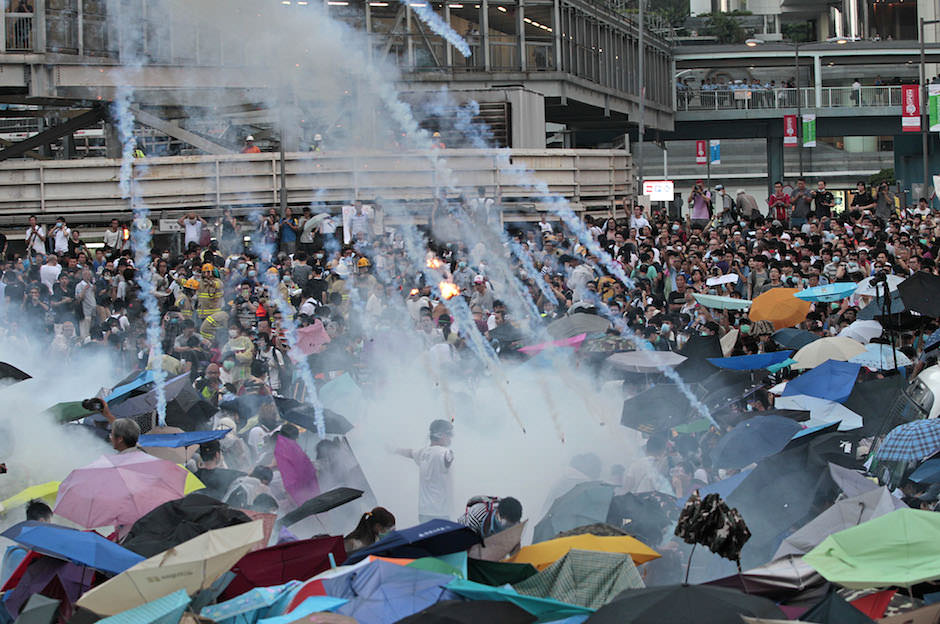A surge of emotion washed through me on Sunday night as I watched tens of thousands of protesters fill the streets of Hong Kong on television. It was the same feeling I had in Beijing on the nights leading up to the killings in Tiananmen Square on June 3 and 4, 1989. Once more we are seeing highly disciplined but angry young Chinese demanding an old-fashioned kind of democracy: freedom to choose their own leaders.
Now again we are watching heavily armed police trying to disperse peaceful democracy protesters. Already they have used teargas and pepper spray—for the first time in Hong Kong in years. And they are possibly awaiting orders to do more than that. I sense again the dread I recall experiencing around 9 PM on Saturday night, June 3, 1989, as the Army and Armed Police began marching into Tiananmen Square.
For months, the protesters have made their cause clear: they want to be able to elect their own local government in the next Hong Kong election in 2017. But Beijing has said that only it can ensure that the next chief executive of Hong Kong is reliably patriotic and will do what the Chinese Communist Party wills. And now it is enforcing that decision with large-scale anti-riot tactics.
In a way I cannot believe it. Can Beijing and its poodle, Hong Kong’s current chief executive C. Y. Leung, be brutal enough to use deadly force? And I mean brutal. They have the will up there in the north to take harsher measures and have shown it in Tibet. (There is also a People’s Liberation Army garrison in Hong Kong, with some 6,000 soldiers, though up to now its presence has been largely symbolic.)
But Hong Kong is different. Even in 1989, when, during the weeks leading up to the Tiananmen killings and on the fatal night itself, hundreds of thousands of people in Hong Kong marched in solidarity with the protesters in Beijing, nothing happened. But of course Hong Kong was still under British colonial rule. At the time, Hong Kong Governor David Wilson publicly voiced support for the Hong Kong demonstrations—and from then on was frozen out in Beijing.
In the current Hong Kong protests, people of all ages are involved, and many of the city’s most prominent political figures: Anson Chan, a sober, dignified woman who was once the chief secretary under Britain’s final colonial governor Chris Patten, who promoted liberal reforms before the 1997 handover to China; Martin Lee, another old-time fighter for democracy and also a low-key but passionate lawyer; Emily Lau, a firebrand from years ago, who took on Margaret Thatcher during one of her visits to Hong Kong—they have all risked tear gassing and detention to stand up for a principle. And now thousands and thousands of young people, whose parents may have marched in 1989, are taking the same risk.
Yet few in the international community seem prepared to stand by them and risk their own relations with Beijing. The British government, which, after all, signed the 1997 treaty in exchange for a guarantee that Hong Kong’s liberal political system would be upheld, has much to answer for, and Prime Minister David Cameron should loudly call on Beijing to honor its pledge for a truly free election in 2017. I doubt this will happen. British officials refused to meet pro-democracy leaders Chan and Lee when they were in Hong Kong a few weeks ago, and Cameron has already shown a cowardly streak when it comes to China, saying and doing anything apparently to secure all-important business deals.
And what of Edward Llewellyn, who was at Chris Patten’s side throughout his years as Hong Kong’s last governor and is now Cameron’s chief of staff? Can’t Lewellyn remind the prime minister what people in Hong Kong have always wanted? Seemingly not.
Then there are the armored PLA personnel carriers, which were spotted in Hong Kong in late August. Will they do whatever they are commanded, as the tanks did in the streets leading into Tiananmen in early June 1989? Will they roll over demonstrators, who are armed with nothing more than umbrellas to protect them from tear gas, as the tanks did in 1989, crushing them to death? Will the soldiers believe, as do many Chinese students abroad today, that in Beijing in 1989 there was an “anti-police riot,” in which “hooligans” shot police and soldiers?
As we used to say about really big countries, we can say today: all eyes are on Hong Kong.



